How To Clean Disc Space On Mac
A full startup disk is something that every Mac user will experience. This problem used to be known equally "Startup disk full" notification. However, on newer macOS versions this message has been inverse to "Your disk is almost full."
But luckily, it's a problem that has many solutions. And in this article, we'll go over:
- What is startup disk full?
- What'due south causing "Your disk is almost total" warning?
- How to gear up startup disk full?
- How to forbid "Your disk is almost total" problem?
However, we as well understand that some people are short on time and simply want to fix startup disk full. And then, if y'all're non really interested in what it is and why it happens, only skip the next ii sections and head to "How to Clean Your Startup Disk".
Or, even better, if you lot're looking how to articulate space on Mac, we'd highly recommend a utility chosen CleanMyMac X. It'll help you make clean up gigabytes of disk space in just minutes (you can download it hither).
Note: if you're running a newer version of macOS, it has a born option of Optimized Storage that is supposed to solve the problem of the full hard drive by moving files into the cloud.

Past clicking "Manage" you tin open the menu and run into what Optimized storage offers. However, it moves junk and useless files to the deject together with your files, and somewhen, you terminate up paying for iCloud storage to store junk. So we yet recommend getting CleanMyMac and actually dealing with actress files rather than simply moving them.
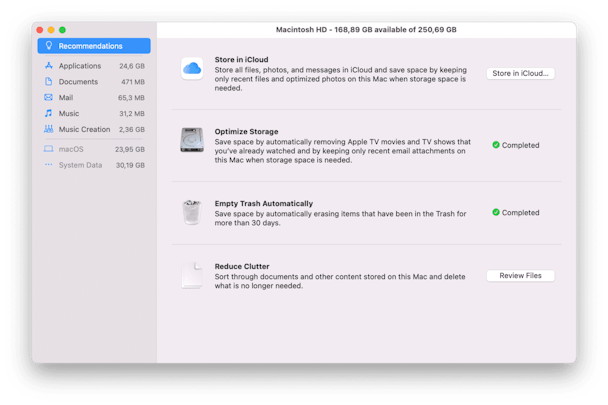
Now, with all that said, let'due south get into what exactly "Your disk is well-nigh total" means.
Understanding What "Your Disk is Almost Full" Ways
What is a startup disk?
A startup disk, as taken from Apple Support article, is a volume or partitioning of a drive that contains a usable operating system. Still confused? Allow's break information technology down for you.
Your Mac hard drive consists of disks (or partitions). Each disk (or sectionalisation) has your Mac data on information technology, which consists of your operating arrangement, applications, etc. Most Mac users take simply i disk but power users may have two or more.
Let'south expect at an case of a Mac with only 1 hd:
- Your Mac's hard drive is 500GB.
- It has i "disk" on it, so all 500GB of storage is on that deejay.
- The disk has an operating system (macOS Monterey), and user information (apps, etc).
- And since you lot just have i disk, this is your startup deejay: all 500GB.
A Mac with two disks will have the storage divided between them. The Mac bulldoze with the OS on it is the startup disk while the other drive is only used for storage of files. Information technology'southward possible to accept multiple startup disks, simply most Macs will only accept one. And for proper disk cleanup on Mac, all drives are just as important.
Why your disk is almost full?
This is easy. Information technology's a lot similar why is your fridge full? There is no more space! Your deejay is almost full and this is very bad news for any drive. A hd should never get beyond 85% capacity (especially a startup disk) as yous will experience slowness and errors the further you get above that mark.
If your startup disk is full and you get a message of warning from your Mac, this is a serious indication that you demand to clear up storageimmediately.
What to do when your disk is almost full?
So how do you lot prepare your almost full startup disk? The aforementioned fashion you solve the problem of a packed refrigerator - you need to clear up storage, of course. To brand more space on your startup disk y'all will need to:
- Delete files from your Mac.
- Move files to an external difficult bulldoze or deject storage.
- Or install a second internal difficult drive on your Mac.
So, now that we know what a startup deejay is, we need to talk about how to fix it. Let's have a closer wait at your disk space to come across exactly what is causing your deejay to be almost full.
What'southward Causing "Your Deejay Is Nearly Total" Alert?
Short version: Take a look under-the-hood of your Mac.
Before we tin run into what is taking up space on your startup disk, offset we have to discover it:
- Hover on the Dock at the lesser of your screen and open Finder.
- Click on "Finder" in the card bar at the top of your screen.
- Then select "Preferences…"
- In the window that opens, checkmark the "Hard disks" checkbox.
Afterward selecting this box, your desktop should now testify the difficult disks on your Mac, in the course of icon(s), like this:
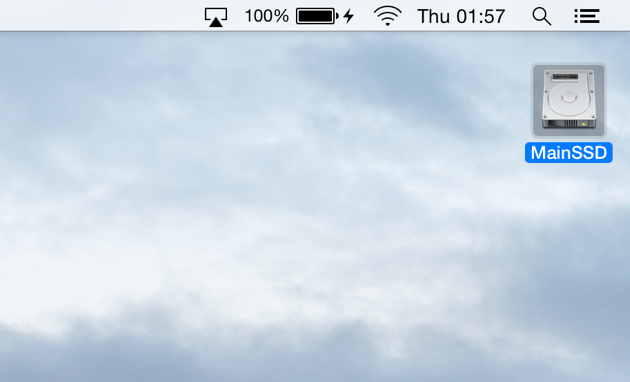
These are disks on your Mac that you lot can "startup", this is because they have operating systems on them. If there is more than one of these hard disk icons that testify up on your desktop, it means you've got multiple hard disks on your Mac. If you only accept one, skip the down to "What is taking upward all of my startup deejay space?" section.
If you have more i, continue with the adjacent step:
Click on the Apple icon at the meridian left of your screen Organisation Preferences > Startup Deejay.
Hither, again, you'll detect your hard disk drive(due south); they're probably named something like MainSSD or MainHD. It will besides display "Bone" and the version number of that Os. If you accept more than one OS drive, your startup disk should be the 1 with the latest version of macOS running on it, just we're going to make sure of that in the next step.
I only take one and it looks like this:
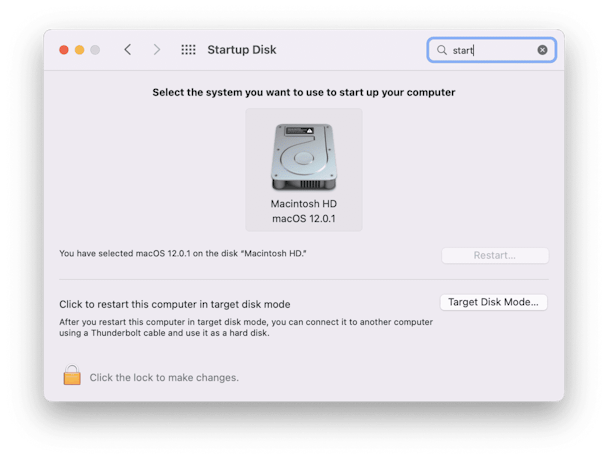
To make 100% sure that you know what bulldoze is your startup disk, follow these steps:
- Click on the Apple tree Icon in the menu at the top-left of your screen.
- Select "Nearly This Mac."
- Under macOS, you lot'll find a version number. Mine is 12.0.1, like so:
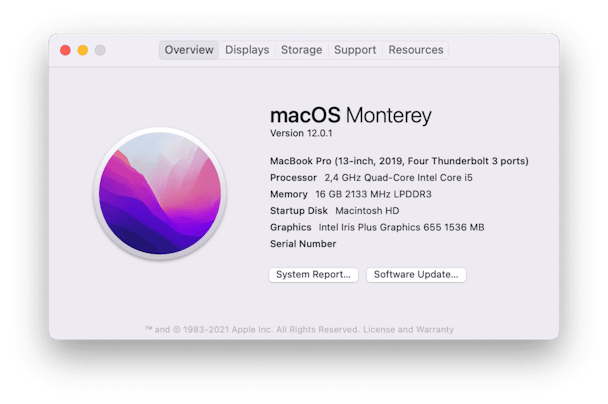
See how my version number in the "Nearly This Mac" window matches the number in my Startup Disk section? Aye — That'due south my startup deejay. Institute yours? Good.
What is taking upwardly all of my startup disk space?
Now that we've identified our startup disk, let's take a closer wait at how to clear up infinite on Mac:
- Click the Apple Icon in the bill of fare at the top-left corner of your screen.
- Cull "Almost This Mac."
- Click Storage.
Annotation: If you lot are running an older version of OS X y'all may take to first click "More than Info…" and so "Storage".
Take a await at my difficult drive disk:

I've got 250GB of storage, and most 168GB of it is complimentary.
So, how big is your hard disk? How much free infinite do y'all accept (if whatsoever — *gulp*)? And what's taking up the most infinite? Information technology is of import to consider drive capacity and information storage needs for hereafter storage plans — nosotros're not just hither to ready the problem, for now, nosotros're going to make sure you lot never accept this problem in the hereafter as well.
At present that nosotros have the cognition, it'south time to take activeness and fix your Mac's "Startup Disk Full" problem.
How to clear disk space on Mac
Let's go over 11 things you can practice to help set "your deejay is almost total." These should also requite you other ideas equally to how else to set information technology — Y'all know your Mac better than we do!
one. Clear system storage on Mac

Organisation storage cleanup sounds like a serious undertaking. Just, technically, it boils down to just one thing: having the courage to chip the sometime files.
- Search for large ZIP/RAR archives in Downloads.
- Open your Desktop (Control + F3) and delete screenshots.
- In Applications, sort your apps by size. Delete the largest ones.
- Restart your Mac to free upwardly RAM.
- Become rid of organisation junk files with a free version of CleanMyMac X.
This app gives you lots of possibilities to gratis upward space, especially when information technology comes to system junk. CleanMyMac X has been notarized by Apple, which basically means it's safe to use. And if you got 5 minutes, try this tool as it shows you where exactly your junk hides.
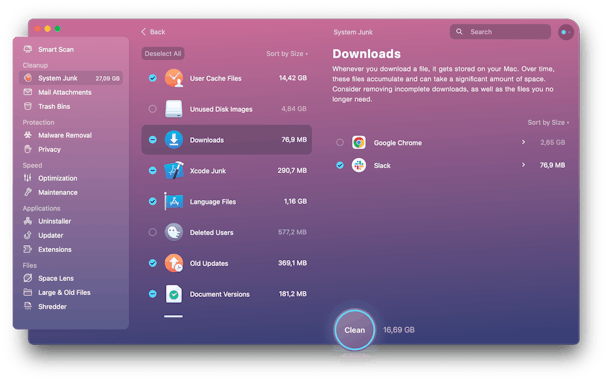
ii. Clean up cache files on your Mac

Cache files are files that help your Mac run programs a fleck more smoothly. Retrieve of them similar blueprints for a house: your Mac has the blueprints for how a programme is supposed to load/run/look, so it loads it faster; without them, it'd be like building it from scratch. However, over fourth dimension, these caches tin can start to accept upwardly some serious space. Periodically, removing them can help clear storage. And don't worry, your Mac volition create fresh, new ones afterwards you restart your Mac. To remove caches:
- Open a Finder window and select Become in the carte bar.
- Click on "Get to Binder…"
- Type in
~/Library/Caches
Delete the files/folders that are taking up the most space. - Now click on "Go to Folder…"
- Type in
/Library/Caches(just lose the ~ symbol)
And, again, delete the folders that have up the most space.
Deleting cache files is mostly prophylactic for your Mac. And in one case you delete them, the applications and processes you lot run on your Mac will generate fresh, new ones. Merely, when deleting, worry more about removing them based on size rather than just removing all of them.
Also, you can check the /Organisation/Library/Caches folder also, but information technology might be better not to bear on this folder without knowing what the items are. A utility that correctly cleans upwards these files (and pretty much everything else on this list) is, y'all guessed it, CleanMyMac X. It cleans up even your system caches with just a few clicks.
Oh, and one time y'all're done with this list, restart your Mac and then it can create these new enshroud files.
Read more: How to Clear Cache on a Mac?
iii. Become rid of localization files

Localization files are also known as "linguistic communication packs." Lots of apps come up with other languages that you probably don't need. To articulate up infinite on your Mac, delete the ones you don't demand:
- Open a Finder window.
- Go to Applications.
- Ctrl+click on an application.
- Select "Prove Parcel Contents."
From here, get to Contents > Resources and look for files ending in .lproj. These are the languages your app has only in instance you lot want to use it in some other language, like Spanish (es.lproj). Drag the ones you'll never use to the Trash.
Over again, a safer alternative to this would exist to use CleanMyMac Ten. It gets rid of all of them with a click. No digging through application folders, but a cleaner Mac.
Read more than: How to Delete Language Files from macOS?
4. Delete indistinguishable files

Fifty-fifty if yous have the most organized Mac on a planet, duplicates happen ane fashion or another. It tin can be a file you've mistakenly downloaded twice or a mail attachment you've opened several times. Regardless of how they appeared, those files sit on your Mac and gobble upward storage.
But finding and deleting them is a time-consuming process if you lot do information technology one by 1. And so here's what you lot can exercise for a uncomplicated Mac disk cleanup:
- Open the Finder app on your Mac
- Move cursor over File and click New Smart Folder
- Click the "+" button in the upper right corner and choose the type of files you want to encounter
- At present sort them by name to quickly spot duplicates.
Call up to pay attention to the date of creation to make sure y'all continue the true original, non the re-create.
While this is the best way to remove duplicates manually, information technology takes lots of your time and dedication. It'd be much easier to leave this to Gemini ii: The Indistinguishable Finder.
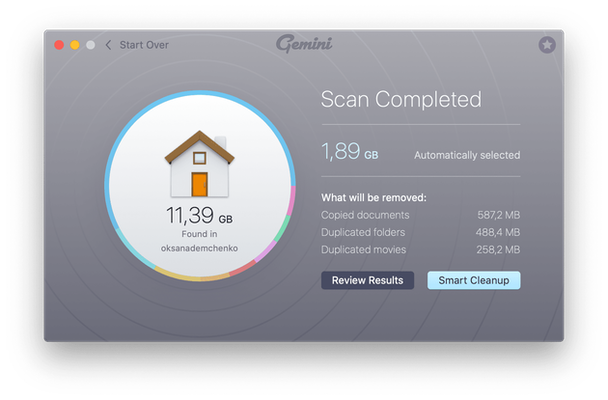
This app speedily scans your Mac for duplicate and similar files and allows you to delete them within minutes. It keeps your originals rubber and helps you hands retrieve files deleted past accident.
5. Remove one-time iOS backups

Backups can tend to accept up a lot of space. You can discover and remove them past:
- Launching a Finder window.
- Clicking "Go" in the menu bar.
- Selecting "Become to Folder…"
- So, type in
~/Library/Application Support/MobileSync/Backup/
Get rid of all the old, outdated backups your Mac has been storing for a bit more actress infinite.
half dozen. Remove large and old files

Keeping many large files on your Desktop and in Documents slows downwards the system. And if you delete only a couple of these enormously large files, you can get one-half of your storage back.
Allow's open the familiar Near this Mac pane in one case over again. If you lot click Manage, you'll see this window for sorting files.
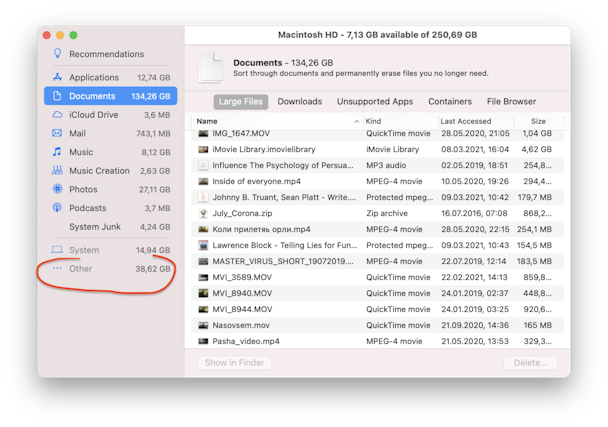
While this instrument is adept for finding large files, it misses a lot of things. See that "Other" category that takes upwards 38.GB?
To deepen your search for massive files, use this tool from CleanMyMac X. It'south called Large & Erstwhile files finder.
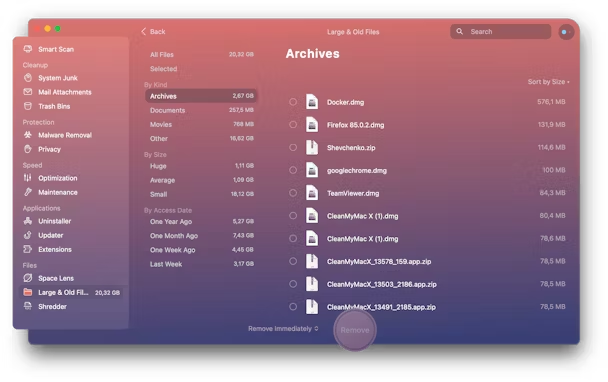
Information technology's much more helpful as information technology shows you lots of other categories of files, like Archives. The app breaks your files past Size and Last Used.
To see this instrument in action, download the free edition of CleanMyMac 10. And click the Large & Old files at the lesser of the sidebar.
7. Remove unnecessary applications

This isn't often overlooked, just definitely under-appreciated. Removing quondam, unused applications is a smashing way to get some actress infinite on your startup disk. Become through your applications folder and go rid of all the apps you rarely use. Simply make certain yous remove them correctly, don't just drag them to the Trash. If you do, you'll leave behind tons of leftover parts and pieces, and nosotros're trying to get back startup disk space — It'll kinda defeat the purpose, no?
This is another identify nosotros'd suggest using CleanMyMac X. To completely remove any application, but launch CleanMyMac X, click Uninstaller, select your application, and and so click Uninstall. You lot won't accept to search all over for development junk that's left behind when Trash'ing an awarding. It'south incredibly piece of cake and saves yous tons of time.
eight. Move your Photos and Docs to the cloud

When your local storage is full to the brim, your Mac volition start uploading this data to iCloud. But only if y'all have this setting enabled. Is your Photos app synced with iCloud already? Let's check.
- Open Applications and find the Photos icon.
- Launch Photos and click on Preferences in the pinnacle menu.
Ticking the box iCloud Photos volition connect your Photos library to iCloud. And what'due south more important, if you lot select Optimise Storage, some part of your Photograph library will be moved to iCloud. This fashion you lot macOS saves precious space. The free iCloud programme allows you to gratis up at least 5 GB worth of storage.
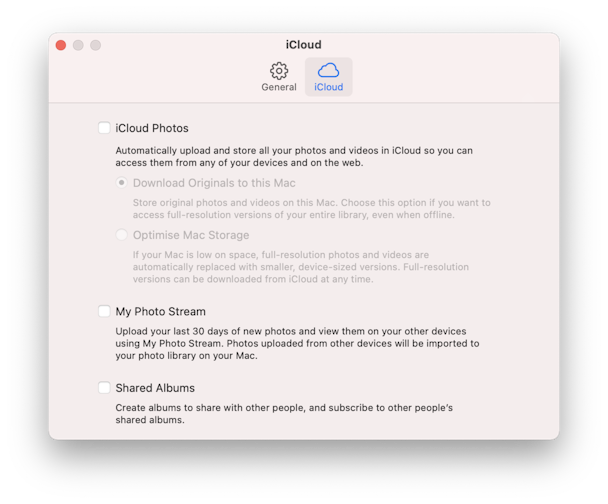
The similar logic applies to your Documents and other files. To prepare the deject fill-in with iCloud drive, get to System Preferences > Apple tree ID > iCloud.
nine. Make clean up your Downloads, Movies, and Music folders

Take a closer await at these three folders. You lot'd be surprised at how many downloads tin accumulate when you aren't paying attention. Clean out annihilation yous don't need (or don't know) and organize the remainder. Information technology'll take a load off your mind to know that in that location'due south naught excess there.
The Movies folder tin can exist a pain, not considering you're searching through tons of files, but it can be difficult to cull what to delete. Personally, I never desire to get rid of Superlative Gun. It'southward amazing. I watched information technology 3 times in a row last weekend. But alas, sometimes y'all need to brand sacrifices for the health of your Mac. Though, what you can do with movies you want to keep is to annal them. So, archive what you wish to continue and remove the rest.
How to archive/compress a file
Archiving a file doesn't hateful to shop deeper into the abyss of your Mac — but to turn the file into something smaller, into a compressed file (similar .zip or .tar). By archiving a file, you shave off some memory. Archiving is essential for things y'all desire to keep on your Mac, but don't often use, and helps you articulate upwards some space. And that's what this is all well-nigh right? We're essentially doing the hokey-pokey on your Mac. To archive a file, merely:
- Control-click the file yous want to compress (recommended for movie files).
- Select, "Shrink ."
The last place to sweep through is the Music binder. Observe and remove duplicate music files first, so clean upwardly all the songs y'all downloaded on a weird Sunday afternoon cleaning the house.
10. Clean your Desktop

"Make clean my desktop… but why?" Because some people'southward desktops are hard to wait at, that's why. Organize your desktop and get rid of the stuff you lot just don't need on there. It looks better and helps your Mac act a flake faster (I don't know the rocket science behind this one, but it feels too good to exist false). Your Mac doesn't waste fourth dimension loading all those icons and junk, but… Just clean it, delight.
eleven. Empty out the Trash (No, we're not joking…)

Seriously: Information technology may sound incredibly basic, but it could clear a surprising amount of storage. I forget to practice information technology all the time. The thing is, that when you lot delete something, your Mac doesn't remove it — it only moves it to the Trash. Plus, you've probably deleted way more than you realize, and all that could be sitting in the Trash, wasting space. So get rid of all that junk past emptying the Trash:
- Control-click your Trash in the Dock.
- Select "Empty Trash."
- And click "Empty Trash."
And, the easiest step is done.

A few more tips to clear storage on Mac
1. Manage your Optimized Storage
This option comes with your operating system starting macOS Sierra. Become to the Apple card > Virtually this Mac > Storage
Now, click on Manage to reveal the space-saving options:

2. Erase your Junk Mail service
Open your Mail app, and click Mailbox in the upper bill of fare. Here you can erase spam and already deleted items.
Full Startup Disk Prevention
We've cleaned upwardly a few things on your Mac, and hopefully, it'due south given you more than ideas as to what else you can clean. Just, permit's take a look at how much space you saved from cleaning the list above. Remember how we checked your Mac's free infinite? Open that window again and see how much space you've cleared up:
- Click the Apple tree Icon in the menu at the summit-left corner of your screen.
- Choose "About This Mac."
- Click Storage.
Note - If you are running an older version of macOS yous may take to first click "More Info…" and then "Storage".
You've probably got a scrap more infinite, and you'll desire to proceed it that style. The only mode to forestall a "your disk is most full" is by keeping your Mac clean. We'd recommend a consummate cleaning every ii–3 weeks.
Say goodbye to the "Your startup deejay is almost total" message.
We've told yous how to delete storage on Mac in multiple ways. Hopefully, this has helped you prepare that full startup disk problem. Your startup disk should now be quite a bit lighter (we hope). Oh, and if you liked this article, get social with it to help others in demand. And if y'all really liked this commodity, subscribe to our email list — nosotros've got more than guides on the way. And we've as well got a utility that'll help you out a ton in the long run: CleanMyMac X. Information technology helps you lot clean your entire Mac with simply the click of a button. Information technology'southward incredibly easy to employ and works like a charm.
Source: https://macpaw.com/how-to/startup-disk-full-on-mac-os-x
Posted by: weldonhatiou.blogspot.com


0 Response to "How To Clean Disc Space On Mac"
Post a Comment